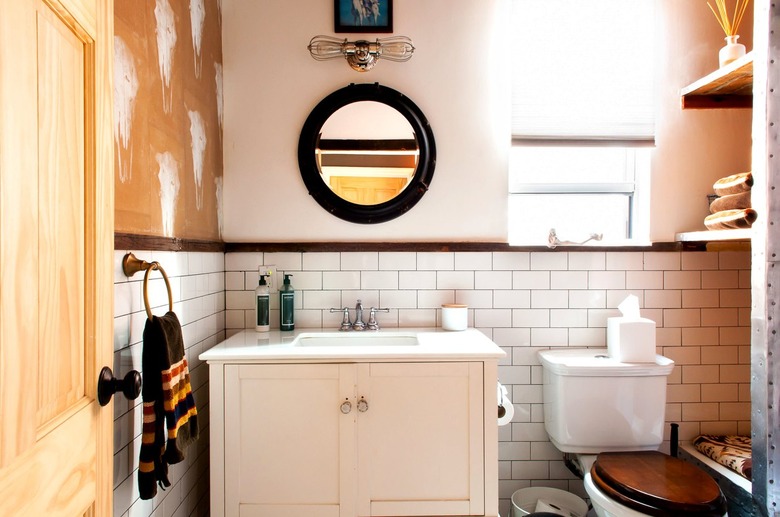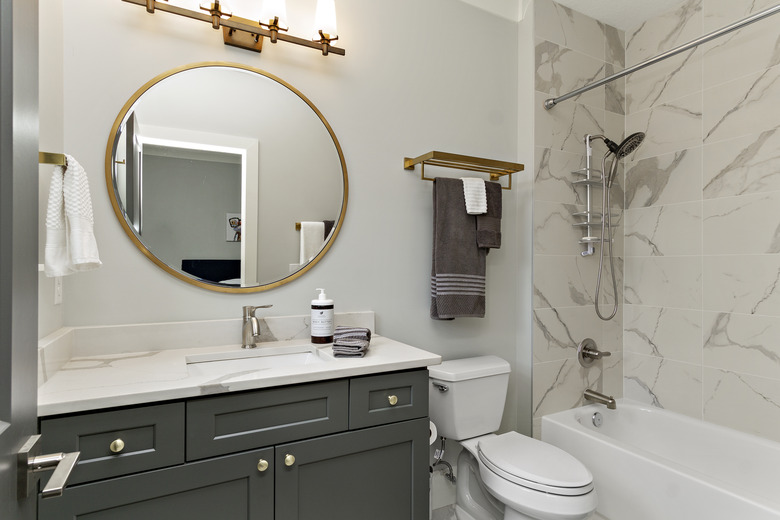How To Clean Mold And Prevent Mold Growth On Bathroom Walls And Ceilings
We may receive a commission on purchases made from links.
Mold growth is not only unsightly but it can also be hazardous to the health of many people as well as contribute to structural damage. There are many ways to clean mold and, more importantly, methods to help keep it from coming back.
While mold may be unwelcome inside the home, it is an important part of nature because molds help break down organic materials. Leaves, grass clippings and food scraps become compost partly because of mold. Mold spores are everywhere (you may be breathing in some right now), but it's still important to eliminate their unfettered growth in high-moisture areas like the bathroom.
Mold Growth Problems
Mold Growth Problems
Mold growth becomes a problem when the spores settle on a wet surface and begin to feed on the surface and grow. There are many different types of mold that can end up in your bathroom, but the most notorious is black mold (Stachybotrys chartarum). Black mold was at one time linked to pulmonary disease in infants, but the Centers for Disease Control and Prevention has concluded that there is no link between black mold and pulmonary disease.
Molds, however, do affect some people, particularly the very young and the very old. People with compromised immune systems are also susceptible to mold-related health problems. Some people are allergic to specific types of mold.
Inhaling or touching mold spores can cause symptoms that resemble an allergy, such as watery eyes, running nose and itchy eyes. Those who are sensitive to mold exposure can also develop skin rashes. In extreme cases, people may have trouble breathing, or mold may trigger an asthma attack. Symptoms can appear upon contact with mold or can be delayed.
Preventing Mold Growth in the Bathroom
Preventing Mold Growth in the Bathroom
When you clean mold, you can use typical household cleaners, but you can't get rid of mold completely because mold spores are always present. However, you can eliminate the moisture that mold needs to survive. The goal is to get rid of standing water, so it's crucial to fix all leaky faucets and pipes. In addition, mold often latches on to areas that may not seem obvious at first, such as water that accumulates at the base of a shower wall or where the tub meets the tile wall.
Keeping the room as dry as possible will help prevent mold. A bathroom exhaust fan that is vented to the outside can get rid of moist air and help dry out the room. The Home Ventilating Institute offers tips on selecting bath fans. For an exhaust fan to be most effective, run it during showers and for about 30 minutes after the shower. You can also run a squeegee over shower doors and walls after use and dry off shower shelves where water can accumulate.
For tile surfaces, make it an annual routine to apply grout sealer to the grout in the room. Many products have applicator tips that let you roll the sealer onto the grout. Replace moldy caulk with silicone mold- and mildew-resistant caulk. And when it comes time to paint the bathroom, use a mold-resistant paint. Keep in mind, however, that large areas of mold — those over about 10 square feet — should be handled by a professional. The Institute of Inspection Cleaning and Restoration Certification can provide a list of local cleaning and restoration contractors. You may need a pro if mold has spread in hidden areas, such as the back side of wallpaper or inside a wall, but most mold problems that pop up in homes can easily be dealt with by the homeowner.
Drywall and ceiling tiles are very porous. If the mold damage is extensive, you won't be able to clean mold properly, so it is best to remove and replace the materials. Don't be tempted to cover up mold problems on the walls with a fresh coat of paint. It won't work. The paint will not adhere properly and the spots will once again be visible through the paint before too long.
Things Needed
-
Bleach
-
Respirator (The Environmental Protection Agency recommends N95 masks. If not available, use a respirator that uses replaceable cartridges.)
-
Spray bottle
-
Scrub brush
-
Microfiber cloths
How to Clean Mold
1. Wear the Right Clothing
Wear a respirator, long rubber gloves — the kind that go up to near the elbow — and goggles. Make sure the space is well-ventilated.
2. Clean Walls and Ceilings
Mix 1 cup of detergent with 1 gallon of water. Use a detergent that does not contain ammonia. Pour it into the spray bottle. Spray the surface and allow it to sit for about 10 minutes. Scrub the area with a brush or cloth. Rinse and let dry completely.
3. Clean Tile Grout
Mix about 1 1/4 cups of bleach with 1 gallon of water. Pour it into a spray bottle and apply it to the mold. Let it sit for 10 to 15 minutes and then scrub the grout with a brush (even an old toothbrush works). Rinse and let it dry.
Never mix bleach with ammonia because the mixture can produce harmful fumes. There are also commercial grout cleaners that you can use.
References
- United States Environmental Protection Agency: A Brief Guide to Mold and Moisture in the Home
- Institute of Inspection Cleaning and Restoration Certification: IICRC Global Locator
- Home Ventilating Institute: Bathroom Exhaust Fans – A Consumer Guide
- Centers for Disease Control and Prevention: Facts about Stachybotrys chartarum

